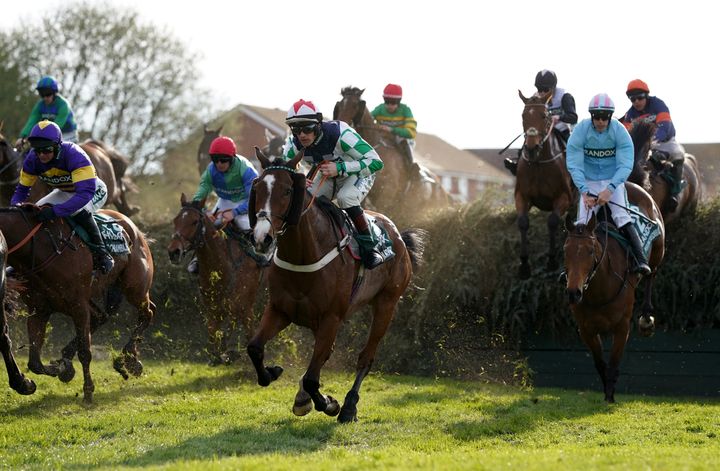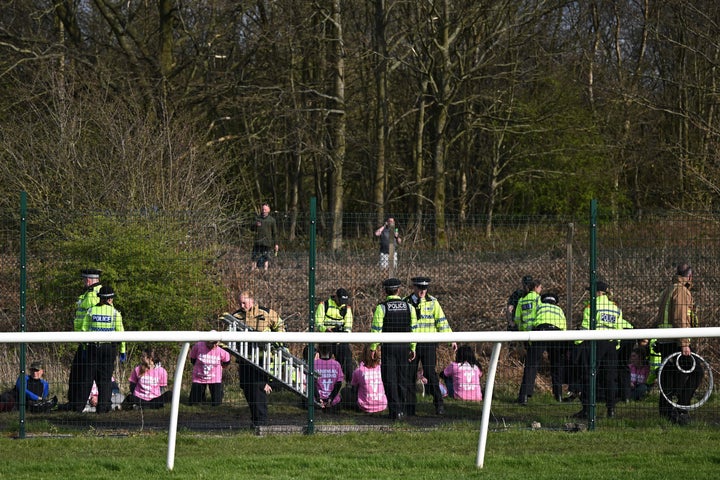
This year’s Grand National has caused a particular stir after three horses died and a flurry of protesters on the racetrack caused significant delays.
Here’s what you need to know.
What is the Grand National?
The Grand National is the name of one annual horse-racing event which has been going since 1839, taking place at the Aintree race course in Merseyside.
The entire race covers just over four miles (6.9 kilometres) and horses jump 30 fences in total, while completing two laps of the track.
Around 40 horses race to win the top prize and millions watch the competition, many of whom have bets placed on various horses.This year, 70,000 were watching from the stands.
It’s the highlight of a three-day occasion called the Grand National Festival, often just called the Grand National.
But, the event is often criticised for the number of equine deaths directly linked to racing.
The Grand National is often accused of having a particularly high death rate compared to other racing events.
Why was this year’s Grand National especially divisive?
Three horses died during this year’s festival: Envoye Special, on Thursday, Dark Raven and Hill Sixteen on Saturday.
The Grand National was also delayed by almost 15 minutes after animal rights activists tried to occupy the track on Saturday and attach themselves to fences and railings, prior to the big race.
More than 118 animal rights protesters were then arrested, with 42 later “de-arrested”, according to animal rights group Animal Rising.

Sixty-five were kept in custody as of Sunday and will be bailed pending further enquiries, according to Merseyside Police.
The force said: “They were arrested on suspicion of a number of offences including conspiracy to cause public nuisance, obstructing highways and possession of controlled drugs.”
Sandy Thomson, who trained Hill Sixteen – the horse which fell at the first fence and was euthanised after it broke its neck – caused further uproar on Monday after claiming the horse was “hyper” due to the protests.
He told The Racing Post: “He just hasn’t taken off at the first fence; he’s got so bloody hyper because of the carry on.”
Thomson said he tried to soothe the horse by washing him off, but it didn’t work.
He continued: “Unfortunately it’s a statistic we’re all trying to avoid. He’s jumped round here twice and never had a bother. I don’t know when he last fell.
“I know how ignorant these people are and they haven’t a bloody clue. They just cause more problems than they ever solve.”

Why do horses die at the Grand National?
Many believe horses die because of the sheer difficulty of the race track.
Animal rights group Peta UK said the Grand National is one of the “longest and most hazardous in the world”, claiming that its “high risk factor” is part of its claim to fame.
The group claimed: “Almost every year, horses are killed during the three-day festival, sustaining horrific and often fatal injuries at notorious fences such as the Chair, Becher’s Brook and the Canal Turn.
“Every time horses are forced to jump over these excessively high obstacles, it puts tremendous pressure on their slender front legs and they risk broken legs, necks and backs.”
It continued: “In some cases, drugs – both legal and illegal – have been administered by trainers and even veterinarians to mask the pain of horses who should have been recuperating so that they could instead be forced to run with injuries, making them worse.
“Even those who make it off the track alive are likely to suffer.
“Thousands of horses – including ‘spent’ thoroughbreds and those who don’t ‘make the grade’ – are discarded like used betting slips every year. They’re abandoned, neglected, or sold for slaughter.”
BHA has actually been trying to improve welfare standards in the sport in recent years, and has claimed that now just 0.2% runners die due to the changes now implemented.
They also point out there have been five deaths from 395 runners in the 10 Grand Nationals races since safety changes introduced in 2012.
What do campaigners want?
Animal Rising, the group which led Saturday’s protest, told Sky News that it acted because it “aimed to prevent” the deaths which occurred after their demonstrations.
It claimed: “Horse deaths and injuries are an unavoidable consequence of the way we use animals for sport, not dissimilar to the way we cause billions of animal deaths in our food system.”
The group said the only way to “prevent more harm” was by “re-evaluating our connection to them”.
They also noted they would “welcome dialogue” with Thomson or Hill Sixteen’s owner, Jimmy Fyffe, about how to “move forward together” and change the relationship with horses.
Animal rights activists are also calling for more safety measures to be put in.
Head of campaigns and communications at the League against Cruel Sports, Emma Judd, also said: “One death is too many. Animal welfare needs to be put before gambling profits and entertainment, and steps need to be taken to end this carnage which is occurring year after year.
“A new independent regulatory body is required which has horse welfare as its number one priority. The use of the whip, which pushes horses beyond what they can safely do, should be banned.”
Animal charity the RSPCA is also calling for a governing body to review the race, too.
Could anything change?
The BHA has promised it will “analyse” the races in “painstaking detail” to help them “understand what caused these incidents” – although it condemned the protesters for being ”reckless”, too.
Head of the Jockey Club, which owns Aintree racecourse, also suggested to Sky News that it’s impossible to completely “eliminate risk” from the sport.
Nevin Truesdale said: “We can’t ignore what happened in terms of the fatalities we saw and every fatality in racing is one too many.”
He claimed “99.8% of horses” who race come back safely, with the fatality rate falling by a third over the past decade.
However, Rob Owers, chief executive of charity World Horse Welfare, suggested there was a way forward.
He explained: ”Whilst it is true that accidents can happen anywhere – and the risks can never be removed altogether – jump racing poses specific risks that it has a responsibility to relentlessly reduce wherever possible.
“It is clear to us that despite the changes made by Aintree and racing to date, much more needs to be done.”
